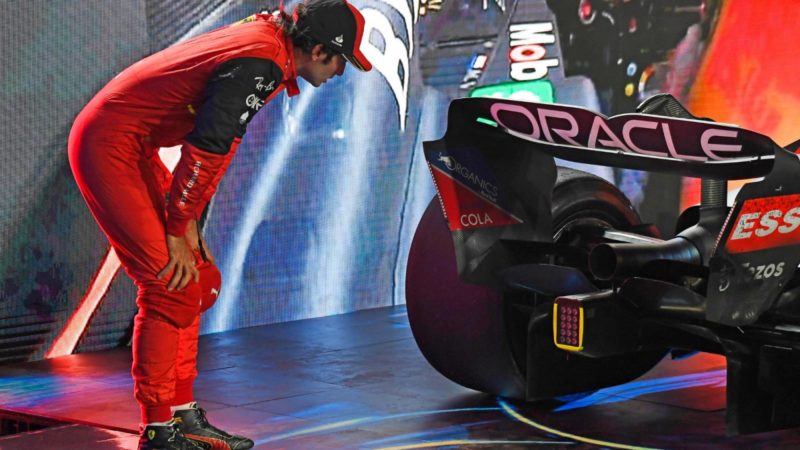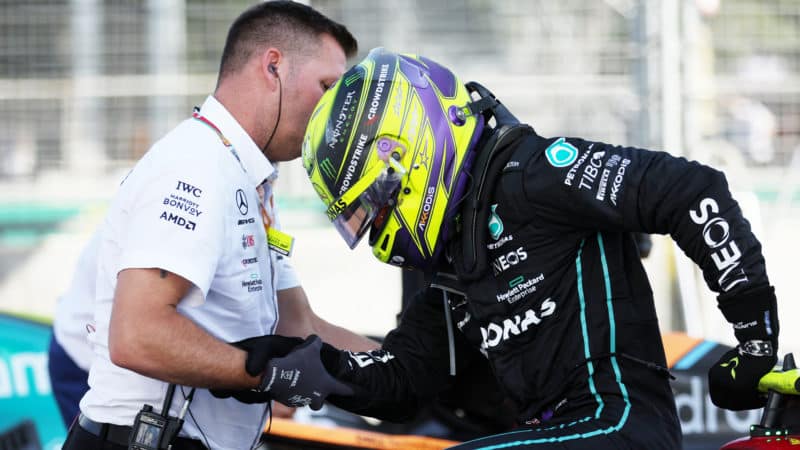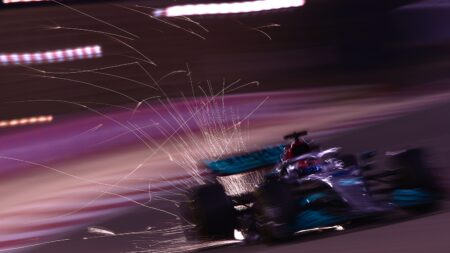Teams have struggled to understand and resolve the porpoising issue, which wasn’t evident in pre-season wind tunnel testing.
The new cars take advantage of ground effect with venturi tunnels in the floor, channelling air from the leading edge, by the sidepods, to the rear diffuser.
The air is accelerated in narrowing sections of the tunnels, reducing the pressure underneath the car, while higher-pressure air above pushes it ever closer to the track surface. If it gets too close, or touches the asphalt, then the airflow stalls with a sudden loss of downforce, causing the car to rise up instantly — at which point the process begins again.
“It’s kind of a multiplication of what we would feel going through a pothole but hundreds of times over different parts of the track continuously at very high speeds,” says Damien Kelly, a physiotherapist and clinical sports director at Physica Health, who works with Formula 1 drivers.
“If in a normal, passenger car you went through a pothole, you would feel a bump right through your body up through your sitting position. Put yourself in a go-kart position, or very close to the floor, with very little shock absorption and go through a pothole, you will feel it going up right through even more.”

Mercedes has been afflicted by bouncing
Mario Renzi/F1 via Getty Images
Following the Azerbaijan Grand Prix, Lewis Hamilton said he had been “holding and biting down on my teeth due to the pain.” Ferrari’s Carlos Sainz said that drivers are struggling to handle the issue, and George Russell has echoed his Mercedes team-mate, complaining of back and chest pain at Imola.
Russell has gone on to raise concerns about long-term health injuries, comparing the situation to that of footballers in the 1960s, ’70s and ’80s who headed heavy footballs, with health consequences that are still being understood. He warned of a “major incident” if the issue is not resolved. Gasly called for changes to the rules to “save us from ending up with a cane at 30-years old”.
Some teams, such as Red Bull and McLaren, appear to have designed out porpoising, while the Ferrari still suffers from bouncing, but with seemingly little effect on its performance. Other teams, including Mercedes are struggling with the issue.
One solution is to increase the car’s ride height to control or eliminate porpoising, but teams are reluctant to do this, as it affects performance. However, they may be left with no choice after the FIA introduced new measures in Canada, which includes monitoring the extent and and the force of porpoising, and setting a limit, which could see cars disqualified if breached.
The high-impact vertical compression of the spine caused when cars bounce is known as axial loading, and squeezes the vertebrae and discs closer together.
“The biggest areas that the bouncing will affect will be the spine and by the spine, I mean through the lower back onto their neck as well,” said Kelly.
“The intervertebral discs that lie in between each vertebrae act as shock absorbers through your spine and when you are in a very flexed position, like the drivers are being sat down with their knees upwards in relation to the hip, that already puts higher forces through those lower back discs.
“Then, if you add vibration and high axial loading through that position, it’s been shown in some lab-based studies that some of them can cause irritation and inflammation of those lower back discs, so that would certainly be one area that can become reactive as a result of porpoising.

Carlos Sainz takes a good look at the RB18, with Red Bull on top of the porpoising issue
Grand Prix Photo
In response, drivers have increased the number of physio sessions, with Gasly explaining that he now has one before and after every time he is in the car.
The strain of driving is multiplied by this year’s 22-race calendar, with nine back-to-back races and lengthy journeys between races: drivers have just made the 5,000 mile, 18-hour trip between Baku for last weekend’s GP, to Montreal for this weekend’s Canadian Grand Prix.
“[Back-to-back weekends] aren’t the ideal way to recover,” said Kelly. “So, you have to put a lot of emphasis on things like treatments, exercise, mobility and stretching.
“You have to be a bit more proactive than let’s say, if you had a week off or just a short haul flight. You’re changing time zones which certainly makes it a lot tougher so you have to also emphasise things like sleep, recovery, hands on treatment or physiotherapy to try and recover quickly for the next weekend.
“It’s likely that some drivers will be in their car in a less optimal condition than they would like.”
Teams don’t see additional padding as the answer, as they are loathe to add more weight to cars that are already on or above the minimum limit. Drivers’ reactions would also likely suffer from cushioning that reduces their feel of the car’s behaviour.
Some drivers were calling on the FIA to change its technical regulations by mandating car design changes, but teams that have already found a remedy are against losing their advantage. “It would seem unfair to penalise the ones that have done a decent job,” said Red Bull’s Christian Horner.
Instead, the FIA’s solution is to set a limit for bouncing, allowing teams to retain their technical freedom and preserving the advantage of cars that are already on top of the problem.
However, teams that still haven’t got to grips with the issue could well be left at a disadvantage. After Baku, Mercedes admitted that it had pushed its car’s setup “too far” in prioritising performance over comfort. It won’t have that option in Canada, where it may have to accept a lower level of ground effect downforce to minimise bouncing, until it can find a longer-term fix.







